
Guests
- Romarilyn Ralstona member of the California Coalition for Women Prisoners, L.A. chapter, and program coordinator for Project Rebound at Cal State University, Fullerton. She was imprisoned for 23 years, during which time she worked as a fire camp trainer.
- Deirdre Wilsonformer program coordinator for the California Coalition for Women Prisoners. She was imprisoned for three-and-a-half years, during which time she worked as a landscaper at a women’s fire camp in San Diego.
California relies on thousands of prisoners, including many women, to battle the wildfires burning statewide. Prisoner firefighters gain training and earn time off of their sentences for good behavior, typically two days off for each day served. But critics of the program say the state is exploiting prisoners’ eagerness to earn time for early release. While salaried firefighters earn an annual mean wage of $74,000 plus benefits, inmates earn just $2 per day with an additional $1 per hour when fighting an active fire. According to some estimates, California avoids spending about $80-$100 million a year by using prison labor to fight its biggest environmental problem. For more, we speak with Romarilyn Ralston, a member of the California Coalition for Women Prisoners, L.A. chapter, and the program coordinator for Project Rebound at Cal State University, Fullerton. Ralston was imprisoned for 23 years, during which time she worked as a fire camp trainer. We also speak with Deirdre Wilson, who was imprisoned for three-and-a-half years and worked as a landscaper at a women’s fire camp in San Diego.
Transcript
AMY GOODMAN: This is Democracy Now!, democracynow.org, The War and Peace Report. I’m Amy Goodman, with Nermeen Shaikh.
NERMEEN SHAIKH: We continue our coverage of the California wildfires with a look at who’s actually fighting the fires. And it may just surprise you. In addition to roughly 7,000 full-time and seasonal California firefighters, the state relies on about 3,500 prisoners, including many women, to battle the blazes. The California Department of Corrections tweeted last week that at least 2,000 prisoners are currently fighting the wildfires burning across the state, including 58 youth offenders. Earlier this month, California Governor Jerry Brown thanked the firefighters on the front lines, including those who are incarcerated.
GOV. JERRY BROWN: You have heard there is a tremendous effort fighting these fires, and I want to personally thank all the firefighters who are on the line—the members of Cal Fire, also the National Guard and the thousands of inmates who are also on the line fighting to protect lives and bring these fires to a quick close, to the extent that’s at all possible.
AMY GOODMAN: Prisoner firefighters live in one of 43 low-security field camps throughout the state and are routinely called upon to fight fires. Prison firefighters earn time off of their sentences for good behavior, typically two days off for each day served. But critics of the program say the state is exploiting prisoners’ eagerness to earn time for early release. While salaried firefighters earn an annual mean wage of $74,000 a year plus benefits, prisoners earn just $2 per day, with an additional dollar per hour when fighting active fire. According to some estimates, California avoids spending about $80 million to $100 million a year by using prison labor to fight its biggest environmental problem.
For more, we’re joined by two women. Romarilyn Ralston, a member of the California Coalition for Women Prisoners, L.A. chapter, program coordinator for Project Rebound at Cal State University, Romarilyn was in jail for 23 years, and while she was imprisoned, she was a fire camp trainer and a clerk for the California Department of Forestry and Fire Protection. Also with us, Deirdre Wilson, former program coordinator for the California Coalition for Women Prisoners. She was imprisoned for three-and-a-half years. She spent a year of her time behind bars as a landscaper at Puerta La Cruz, a women’s fire camp in San Diego.
We welcome you both to Democracy Now! Romarilyn, let’s begin with you. Explain what these fire camps are. People who are watching or listening right now might be completely shocked to hear that prisoners are on the front lines of fighting these fires. Explain what the program is.
ROMARILYN RALSTON: The program is a way for incarcerated people to get trained in firefighting. Wildland firefighting is something that we hope incarcerated people can use on the outside, post-release. People join the firefighting crews, sometimes voluntarily, when they are incarcerated. Sometimes they are assigned to the fire camp training program because of their low-level offenses. And so, especially for women, it’s a way to earn two days off your sentence. It’s a way to give back to your community. It’s a way to get closer to your family, to your children. And it’s a way to get out of the normal prison setting, which is—
AMY GOODMAN: When you say get closer to your children, you mean that kids can come to the fire camp to see you?
ROMARILYN RALSTON: The visiting process is very different at the fire camps. It’s more open. It’s a more relaxed environment. And it’s more conducive for family visiting, yes.
NERMEEN SHAIKH: And, Romarilyn, can you explain why—you just mentioned the fact that incarcerated prisoners who have worked as firefighters, once they’re released, they can’t actually be employed as firefighters. Could you explain why?
ROMARILYN RALSTON: Yes. The firefighter training that you receive while you’re incarcerated, you don’t get enough of the training needed to apply to Cal Fire. Because of licensing, incarcerated firefighters are not—or folks with a criminal record, once they are released, are not able to get an EMT license. And that’s one of the critical pieces to applying for these jobs post-release. You need to have an EMT certification, and you need to have fire science training, which you get a little bit of that when you’re going through the classroom training. But there’s college credits, there’s other things, that help you to rank higher in these application processes. And so, you don’t get a lot of the training that’s needed to get these jobs post-release. You have the experience, the front-line experience. You have placed your life on the line. You’ve protected California. You’ve saved lives and property. But they don’t take into consideration all of that experience that you have on the front line. They are still looking for a certain degree of training and licensing in order to employ you.
And we think that that’s wrong. The state of California, in their training of incarcerated firefighters, should provide the same training that they provide for folks on the outside. If they don’t want to do that, then they should give credit for the work that folks do on these fires, and consider that training as enough for them to get jobs post-release, because it is. If it’s enough to fight while you’re incarcerated, if it’s enough for you to fight the fire while you’re incarcerated on the training that you received inside the prison, it should be enough once you’re released.
AMY GOODMAN: Deirdre Wilson, I wanted to bring you into this conversation. How much do prisoner firefighters make?
DEIRDRE WILSON: Well, the people in the fire camps, it’s $2 a day. But when you’re out fighting a fire, it’s a dollar per hour.
AMY GOODMAN: Some have criticized this as slave labor. Your thoughts?
DEIRDRE WILSON: Yeah, and the contradiction in what Romarilyn was speaking about in terms of people getting positions when they’re released. If the intention was really to rehabilitate and set people up for success once they’re released, they would have a program, say, where people that had had the training had some kind of continued interim training where they were supported specifically in their situations to go on and have a career. But that does not exist. People fall through the cracks, because the intention is really to make use of this labor that the state is saving $100 million on.
NERMEEN SHAIKH: Well, Deirdre, it’s interesting to note that the state of Arizona also uses incarcerated firefighters, but in Arizona they’re allowed to start a career once out of prison. Now, of course, California does not permit that. Do you know of any attempts in the California Legislature to alter this?
DEIRDRE WILSON: That would be Romarilyn’s—I think she’s on for that question.
AMY GOODMAN: Go ahead, Romarilyn.
NERMEEN SHAIKH: Romarilyn, go ahead.
ROMARILYN RALSTON: Governor Brown did propose approximately $26 million to create a training and certification program that would help support incarcerated firefighters in receiving the training that they need post-release. We don’t know where that is or how that’s going to all wash out in the end, but that is part of the budget proposal for this year. And so, we hope that—knowing what we know about California, and you’ve heard Governor Brown earlier speaking about, these fires are just going to continue, and with global warming, they’re going to continue to get worse. So, if we’re going to use incarcerated firefighter labor to fight fires, we need to respect their expertise once they are released, and give them jobs, because the collateral consequences of not doing that is California going up in smoke. And so, we can’t afford that.
AMY GOODMAN: David Fathi—
ROMARILYN RALSTON: There’s a lot of ways that incarcerated firefighters can get that training inside. They have the means to do it.
AMY GOODMAN: The director of the ACLU’s National Prison Project told The Atlantic last year, “You have to understand the uniquely coercive prison environment, where few things are clearly voluntary. … In light of the vast power inequality between prisoners and those who employ them there is a real potential for exploitation and abuse.” And, of course, there’s a real potential here—in addition to exploitation and abuse, we’re talking about life-and-death situations. Can you explain what life is like on the front lines for a prisoner firefighter, Deirdre?
DEIRDRE WILSON: It’s exhausting. My particular job was—inside the camp, I was a landscaper. I was supposed to work as a clerk, because I have administrative experience, but I had spent time in CIW, so I knew too many people, and they didn’t trust me in the office, so that was why I was sent out to pasture, as I call it, to do landscaping. So I wasn’t actually out on a fire line, also because I was vulnerable to poison oak, which a lot of people are, and when you breathe poison oak in the air if you’re allergic, your throat can close up, and you can die. So that was a concern. And my whole purpose was to get back to my children, as it is for so many people that go to fire camp, is to reduce your time, to get out and be with your families. So, when they say it’s volunteer, that makes me kind of—
ROMARILYN RALSTON: Yeah.
DEIRDRE WILSON: I mean, we didn’t volunteer to go to prison. We didn’t enter prison in order to go to the fire camp and fight the fires. So it’s really not truthful to say it’s volunteer. That’s [inaudible]—
AMY GOODMAN: I mean, this is an absolutely critical point. Romarilyn, have people died on the front lines fighting fires?
ROMARILYN RALSTON: There are reports that incarcerated people have lost their lives fighting fires. But back to the point on volunteering, you know, you have to fit a criteria to be assigned to fire camp, and so it’s a little different for folks who are sentenced with serious offenses or a life term. And so, as Deirdre said, the volunteer part really doesn’t hold. Folks volunteer or get assigned to these positions because of the credits that you can earn. You want to get that day for day or that half time or third time. You want to get back to your family and your children. That’s what’s important.
NERMEEN SHAIKH: Romarilyn, before we conclude, very quickly, some have expressed concerns that opposition to the program may actually lead to its end, which would ultimately be worse for prisoners. Would you agree with that?
ROMARILYN RALSTON: I would—I would kind of agree with that. I think if we could get the certification and the training that Governor Brown is proposing in his budget, so that when folks are released, that they’re able to be hired by Cal Fire and work for that $74,000 a year that other firefighters make—it costs the state of California almost $80,000 to incarcerate a person a year. And when you’re released, there are so many barriers to employment because you have a criminal record. And if we can use the experience of incarcerated firefighters to get those jobs on the outside, it’s just good governance for California.
We want to reduce the prison population. Governor Brown has been under mandate to do that for a while now. We want folks to have access to good employment, so that they don’t recidivate, and they’re able to take care of their families and be contributing members of society. Everyone wants that. People say they believe in second chances. Here is an opportunity for thousands of people to have that second chance, to have the ability to take care of themselves and their families and to become contributing members to the California economy, which is the fifth-largest economy in the world. And yet we hesitate to do that.
AMY GOODMAN: We have to leave it there, Romarilyn, but we will certainly come back to this issue. Romarilyn Ralston, California Coalition for Women Prisoners, L.A. chapter, and Deirdre Wilson, former program coordinator for the California Coalition for Women Prisoners, both speaking to us from Irvine, California.
This is Democracy Now! When we come back, today is the 73rd anniversary of the U.S. dropping an atomic bomb on Nagasaki. We’ll speak with a survivor. Stay with us.

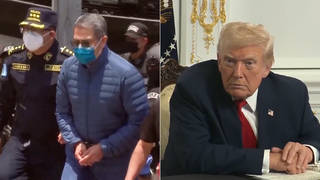
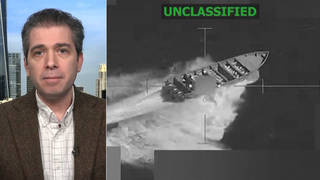
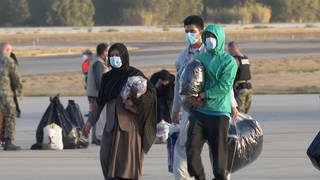
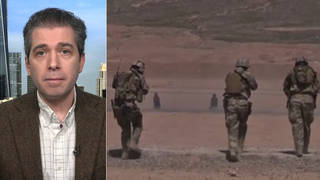





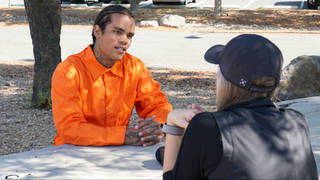

Media Options